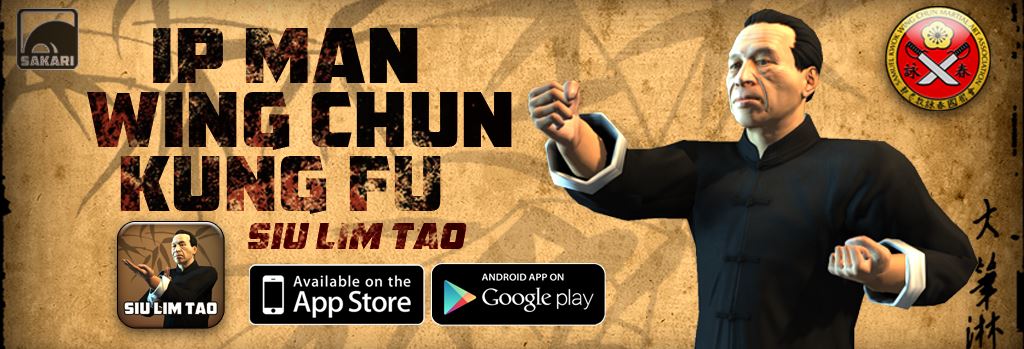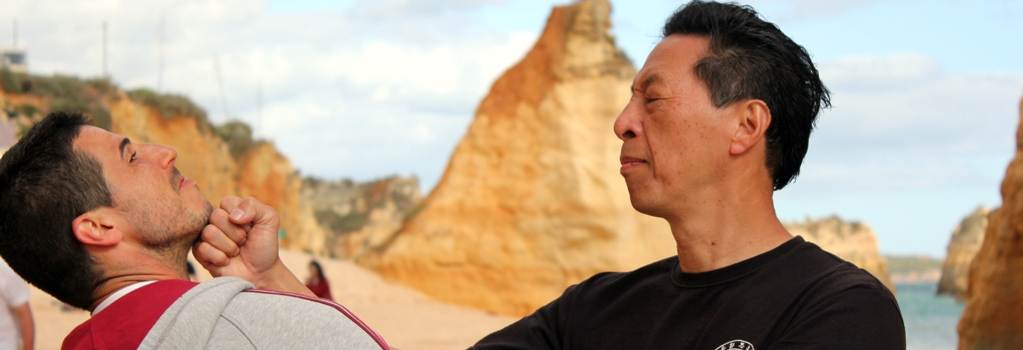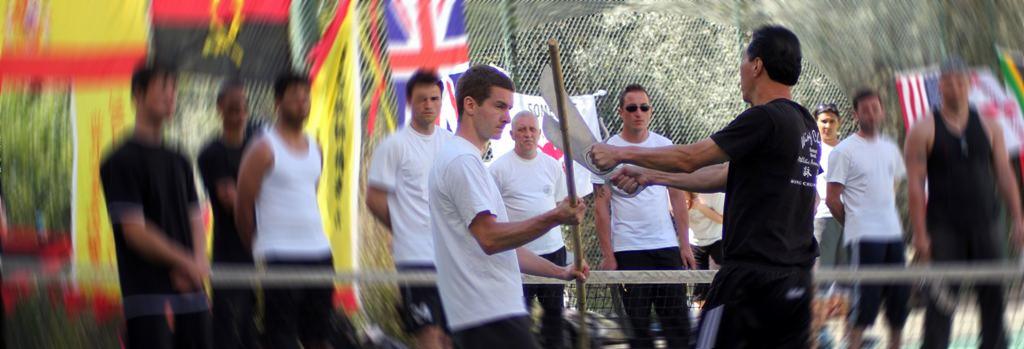Chi Sau Facts and Methods
Article by Dan Knight added on 1 Aug 2012. Last updated on 12 Feb 2014.
Traditional Chi Sau ideas and training methods
The aim of this article is to give students and idea about why they should learn Chi Sau (sometimes called sticking hands, sticky hands or Chi Sao) and what is the right way to go about learning it. I wont cover exact positions or techniques in any detail here. Watch videos and get your instructor to show you how to Chi Sau if you don't know how to do it.
What is Chi Sau for?
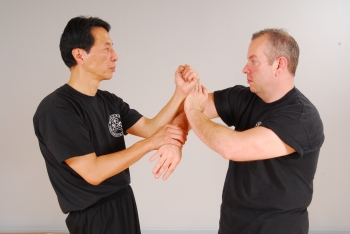
Chi Sau is there to make you a better fighter. It is a means to an end. Being good at Chi Sau itself does not make you a good fighter, Chi Sau is there to help you practice applying techniques and theories you learn in the hand forms. When you get in a fight you can't solve it by asking your opponent to Chi Sau. But hopefully Chi Sau has given you a chance to practice techniques and theory's against lots off different people (of different size and shape) so you know what is effective and you know what makes you vulnerable.
When should I learn Chi Sau?
There is not a simple answer to when to start Chi Sau. It is much harder to learn than say learning the hand forms. Therefore if someone is a slow learner they shouldn't rush into Chi Sau. The flip side is that some people learn quickly and could begin learning Chi Sau after just a few months of regular (perhaps daily) training. Because some people find it very hard to begin with it can put them off of Wing Chun. I would recommend making sure students have a basic knowledge of the hand techniques, then they should spend a little time practicing Dan Chi Sau (single hand Chi Sau) and the Bong Lap Drill. Once the student can perform these 2 drills without thinking they should move onto Chi Sau. Avoid spending too long on drills of any sort (including Dan Chi Sau). This is because they are not useful at making you fight better because a predefined structure has been laid out between the participants for the drill, this will not happen in a fight. The only befits of doing drills is to help beginners learn the technique and get used to responding to touch (feeling the punch coming) rather than sight. This leads to my next point.
Chi Sau is not a drill
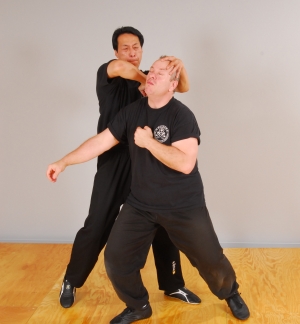
A drill has a predefined set of movements that each person follows. For instance you punch I do a Pak Sau you counter with a Pak Sau and punch again... etc. Chi Sau on the other hand only has a starting set of movements. Each persons starts with their left hand in Fok Sau and right hand moving between Bong Sau and Tan Sau but the second Chi Sau starts anyone can do any attack. Obviously beginners should listen to the class instructor and take it slow or they will not benefit form Chi Sau. But advanced students or students from other martial arts should use Chi Sau as an opportunity to test what works. Students sometimes ask me "Can I do this in Chi Sau" whatever "this" happens to be my answer is always the same. Yes you can do anything, if you do it and you get hit you should consider if it was really a good idea to do it, if you do it and it works (you hit them or stop yourself getting hit or get out of a trap etc) then you should test it on different people and if it still seems to be working well then you have learned something useful. If it didnt work and you got hit or ended up in a bad position etc then you have also leaned something, i.e. if you do something that way you get hit, so you need to look at other ways of doing it or abandon the technique.
Is Chi Sau competitive?
Chi Sau is there to help both students learn. Wining or loosing is not part of Chi Sau, as I said at there start it is there to make you a better fighter it is not a way to fight. Inevitably students will be competitive and a little competitiveness keeps Chi Sau useful. If I am trying hard not to get hit and trying hard to get through the other persons defense it makes it a realistic, and unpredictable exercise. This is useful. However the ultimate goal is to learn so if you just scrap with your partner with the aim of "scoring points" then you will not be learning. Do not be afraid to get hit even by beginners who have not been training as long as you. Every time you get hit you are given an opportunity to learn. You get the chance to find something about your defense that could potentially save you in a real fight. For instance if your Tan is too low and the person is taller they can hit over the top. You should always work with your partner. Chi Sau is not a competition and should not be one, take it seriously but don't aim to be the winner. Take breaks to ask each other questions about what is going on. This is very important in Chi Sau. For instance you can ask: How did you hit me then? What was that combination? Why do you leave your guard low? I think if you used a Biu sau you could stop my attack better... etc.
Some methods of Chi Sau
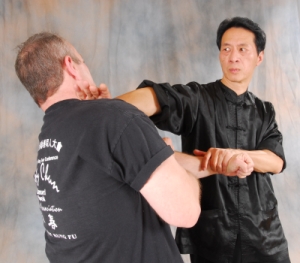
So I mentioned you should look at Dan Chi Sau and the Bong Lap Drill before you start Chi Sau. But once you're under way there are lots of ways to isolate different areas of Chi Sau. For instance:
Just defend
after a while you may realize you can hit absolutely anyone in Chi Sau, they may be better than you or hit you more but if you try hard you can always find good ways to attack faster than your opponent can defend. So when you get to that stage it's time to work on your defense. One way to do it is to never attack in a Chi Sau session. Just work on your defence while your opponent attacks, a strong defense is much harder to master than a strong offense.
Just attack
If your defence is good just work on your attack, the will mean your partner has to work on their defence, but when you have made some progress you can swap over.
Shut your eyes
This is actually much easier than it sounds. Doing Chi Sau with a blindfold on isn't really a great deal harder. This will give you a chance to work on your sensitivity. You should feel for the attacks and feel for the positions. In turn this will enable you to react much faster. Start off slow and make sure you partner has enough control to stop if you can't defend.
On step Chi Sau
Stop after every move in Chi Sau, the aim is to give you time to think what is best, give and receive feedback with your partner and check your positions. The aim is to defend and counter attack in as few movements as possible, this will streamline your Chi Sau making it much more effective. Often a turning strike is enough to defend and get your own strike in.
Fan Sau
This refers to the continued attacking and controlling of a person. Read up on Fan Sau here. When you understand it, to practice it in Chi Sau, simply attack until you hit (get through their defense) the other person several times, or get hit lots yourself. This is sort of the opposite of one step Chi Sau. Be careful when training this and make sure you practice how to defend against it. You will find the Bong Sau is a good way to cut off the momentum of a Fan Sau against you.
Break Away Chi Sau
Also sometimes called Gwoah Sau. This is just where the Chi Sau participants beak contact and then regain contact, this allows the practice of entry techniques or techniques from only one hand contact. It is very useful and translates well into sparring later.
Chi Gerk
Chi Gerk is Chi Sau but with the legs (Sau is hand Gerk is leg in Cantonese). This is not for beginners. Advanced students can train it on its own by locking arms and trying to control the opponents leg and kick out their supporting leg while they do the same. However students can also simply add kicks and sweeps to Chi Sau. Doing this will add lots of levels of complication and can mean you loose the usefulness of Chi Sau. I would recommend using legs only with advanced students and using it when you end up trapping each other or are in a "stale mate". It can also be used to highlight a weak stance however just standing kicking each other in the legs can be a painful and not very useful process so shin pads and control are also recommended.
Is Sticky Hands a good name for Chi Sau
No. Lots of people call Chi Sau sticking or sticky hands, but the aims is not to just stick to your opponent. You should stick to your opponent until there is an opportunity to hit or a loss of contact (at which point you should rush in and hit or regain contact). Chi in Cantonese refers to energy whilst the meaning is quite complex and used in a variety of different ways, the meaning behind the translation of Chi Sau would be more accurately described as sensitivity in the contact between hands to gain information about how to control or attack your opponent. This is quite a mouthful so Chi Sau should probably be referred to as Chi Sau to avoid confusion about the actual purpose of Chi Sau. Remember sticking is only one part
Some footage of Ip Ching demonstrating the uses of Bong Lap. Full footage available in the downloads section in the on line shop.

